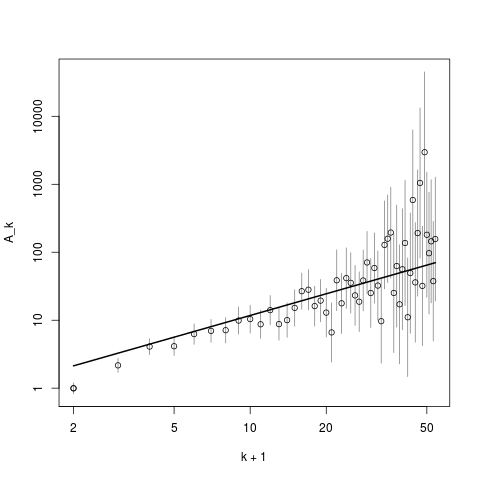Supported by Dr. Osamu Ogasawara and  providing providing  . . |
|
Last data update: 2014.03.03 |
A statistical sound method for joint estimation of the attachment function and node fitness in a temporal complex network by maximizing a suitable penalized log-likelihood functionDescriptionA method for estimating jointly the attachment function A_k and node fitness f_i of a temporal complex network is implemented in this package. The network's growth is assumed to follow a modified version of the fitness model, in which newly added edges, including newly edges between existed nodes, are connected to a degree k node v_i with probability proportional to the product of the attachment value A_k and the fitness value f_i. The method makes no assumption on the functional form of either A_k or f_i. By choosing suitable regularizations, good estimations of A_k and f_i can be obtained by maximizing the corresponding penalized log-likelihood function. We also implement a fast estimation of confidence intervals based on the Hessian of the penalized log likelihood. See the accompanying vignette for a tutorial. If you use this package for your projects, please run the command: citation("PAFit") for a list of references you should cite. Details
Author(s)Thong Pham, Paul Sheridan, Hidetoshi Shimodaira. Maintainer: Thong Pham thongpham@thongpham.net References1. Pham, T. and Sheridan, P. and Shimodaira, H. (2015). Nonparametric estimation of the preferential attachment function in complex networks: evidence of deviations from log linearity, in press. Proceedings of ECCS 2014: European Conference on Complex Systems. 2. Pham T, Sheridan P, Shimodaira H (2015) PAFit: A Statistical Method for Measuring Preferential Attachment in Temporal Complex Networks. PLoS ONE 10(9): e0137796. doi:10.1371/journal.pone.0137796 (http://dx.doi.org/10.1371/journal.pone.0137796) Examples
library("PAFit")
data <- GenerateNet(N = 1000,m = 1,alpha = 1, mode = 1, shape = 0, rate = 0)
stats <- GetStatistics(data$graph)
result <- PAFit(stats,only_PA = TRUE)
plot(x = result,data = stats,plot = "A")
Results
R version 3.3.1 (2016-06-21) -- "Bug in Your Hair"
Copyright (C) 2016 The R Foundation for Statistical Computing
Platform: x86_64-pc-linux-gnu (64-bit)
R is free software and comes with ABSOLUTELY NO WARRANTY.
You are welcome to redistribute it under certain conditions.
Type 'license()' or 'licence()' for distribution details.
R is a collaborative project with many contributors.
Type 'contributors()' for more information and
'citation()' on how to cite R or R packages in publications.
Type 'demo()' for some demos, 'help()' for on-line help, or
'help.start()' for an HTML browser interface to help.
Type 'q()' to quit R.
> library(PAFit)
> png(filename="/home/ddbj/snapshot/RGM3/R_CC/result/PAFit/PAFit-package.Rd_%03d_medium.png", width=480, height=480)
> ### Name: PAFit-package
> ### Title: A statistical sound method for joint estimation of the
> ### attachment function and node fitness in a temporal complex network by
> ### maximizing a suitable penalized log-likelihood function
> ### Aliases: PAFit-package
> ### Keywords: package fitness model Preferential Attachment function
> ### Minorize-Maximization algorithms Barabasi-Albert model MM algorithims
> ### Bianconi-Barabasi model fitness maximum likelihood function
>
> ### ** Examples
>
> library("PAFit")
> data <- GenerateNet(N = 1000,m = 1,alpha = 1, mode = 1, shape = 0, rate = 0)
> stats <- GetStatistics(data$graph)
> result <- PAFit(stats,only_PA = TRUE)
> plot(x = result,data = stats,plot = "A")
>
>
>
>
>
> dev.off()
null device
1
>
|
